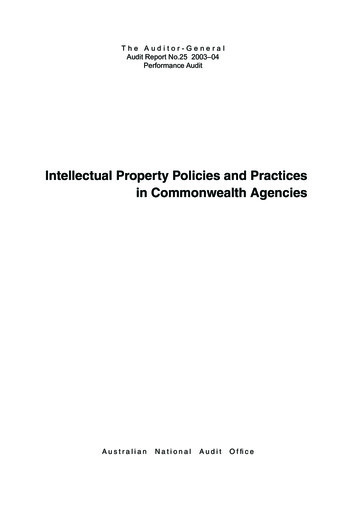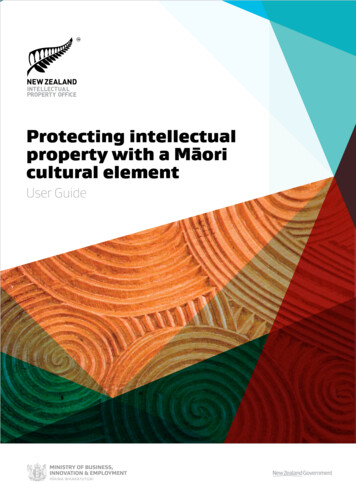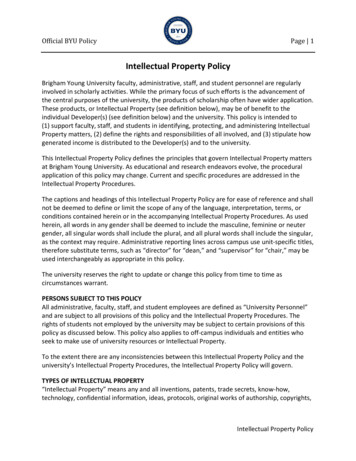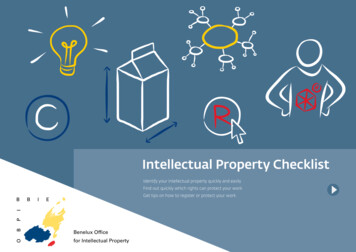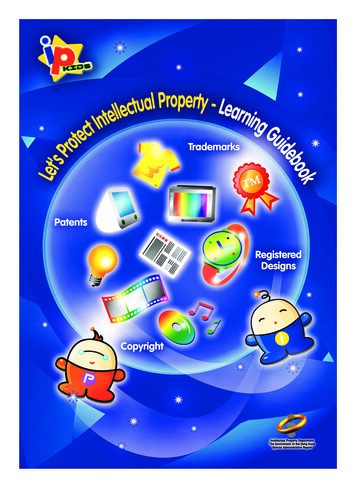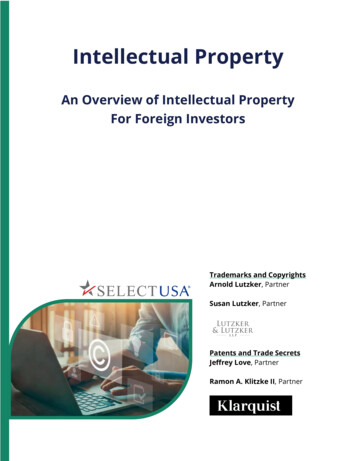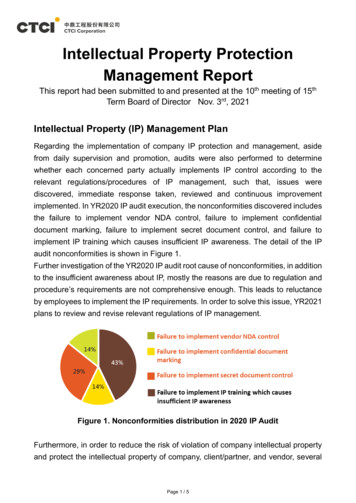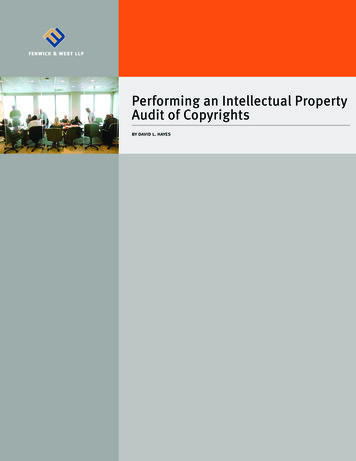
Transcription
Performing an Intellectual PropertyAudit of Copyrightsby david l. hayes
fenwick & west llpAbout The FirmFenwick & West LLP provides comprehensive legal services to high technology andbiotechnology clients of national and international prominence. We have over 250 attorneysand a network of correspondent firms in major cities throughout the world. We have officesin Mountain View and San Francisco, California.Fenwick & West is committed to providing excellent, cost-effective and practical legalservices and solutions that focus on global high technology industries and issues. Webelieve that technology will continue to drive our national and global economies, and lookforward to partnering with our clients to create the products and services that will helpbuild great companies. We differentiate ourselves by having greater depth in ourunderstanding of our clients’ technologies, industry environment and business needs thanis typically expected of lawyers.Fenwick & West is a full service law firm with “best of breed” practice groups covering:nCorporate (emerging growth, financings, securities, mergers and acquisitions)nIntellectual Property (patent, copyright, licensing, trademark)nLitigation (commercial, IP litigation and alternative dispute-resolution)nTax (domestic, international tax planning and litigation)Intellectual Property GroupFenwick & West’s Intellectual Property Group offers comprehensive, integrated adviceregarding all aspects of the protection and exploitation of intellectual property. Fromproviding sophisticated legal defense in precedent setting user interface copyright lawsuitsto prosecuting arcane software patents, and from crafting user distribution arrangementson behalf of high technology companies to implementing penetrating intellectual propertyaudits, our attorney’s technical skills enable the Firm to render sophisticated legal advice.Our OfficesSilicon Valley CenterEmbarcadero Center West801 California Street275 Battery StreetMountain View, CA 94041San Francisco, CA 94111Tel: 650.988.8500Tel: 415.875.2300Fax: 650.938.5200Fax: 415.281.1350For more information about Fenwick & West LLP, please visit our Web site at: www.fenwick.com.The contents of this publication are not intended, and cannot be considered, as legal advice or opinion. 1997 Fenwick & West LLP. All Rights Reserved.
fenwick & west llpPerforming an Intellectual Property Audit of CopyrightsTable of ContentsI. Introduction . . . . . . . . . . . . . . . . . . . . . . . . . . . . . . . . . . . . . . . . . . . . . . . . . . . . . . . . . . . . . . . . . 1II. Audit of Copyrights . . . . . . . . . . . . . . . . . . . . . . . . . . . . . . . . . . . . . . . . . . . . . . . . . . . . . . . . . . . 3A. Ownership Issues: Background . . . . . . . . . . . . . . . . . . . . . . . . . . . . . . . . . . . . . . . . . . . 3B. Ownership Issues: The work Made for Hire Doctrine . . . . . . . . . . . . . . . . . . . . . . . . . 3C. Ownership Issues: Joint Authorship . . . . . . . . . . . . . . . . . . . . . . . . . . . . . . . . . . . . . . . 8D. Ownership Issues: Termination Rights . . . . . . . . . . . . . . . . . . . . . . . . . . . . . . . . . . . . . 13E. Ownership Issues: Recordation of Transfers & Security Interests . . . . . . . . . . . . . . 15F. Ownership Issues: Employee Agreements . . . . . . . . . . . . . . . . . . . . . . . . . . . . . . . . . . 21G. Ownership Issues: Summary . . . . . . . . . . . . . . . . . . . . . . . . . . . . . . . . . . . . . . . . . . . . . 24H. Compliance with Statutory Formalities . . . . . . . . . . . . . . . . . . . . . . . . . . . . . . . . . . . . 25I. Issues of Infringement: Rights of Third Parties . . . . . . . . . . . . . . . . . . . . . . . . . . . . . . 29J. Issues of Infringement: Clean Room Procedures . . . . . . . . . . . . . . . . . . . . . . . . . . . . . 31K. Issues of Infringement: Potential Defenses . . . . . . . . . . . . . . . . . . . . . . . . . . . . . . . . . 34III. Conclusion . . . . . . . . . . . . . . . . . . . . . . . . . . . . . . . . . . . . . . . . . . . . . . . . . . . . . . . . . . . . . . . . . 35
I. IntroductionFor many companies in the computer industry and other information-related industries,intellectual property may comprise a substantial, if not the major, part of the company’sassets. The company therefore has a crucial interest in ensuring that appropriate steps aretaken to create, perfect and maintain intellectual property assets. Creditors lending to suchcompanies also have an important interest in ensuring that such intellectual property assetsare preserved and perfected, as creditors often wish to take security interests in theintellectual property assets of the company.A growing number of companies, both large and small, are acquiring high-technologycompanies or the proprietary rights to state-of-the-art products. Such acquisitions quicklymake available technology that would have taken years to develop internally and allowcompanies to move into market niches not otherwise available to them.Acquiring technology-based assets, however, is somewhat more complicated than acquiringmore traditional tangible assets such as buildings, finished goods or raw materials.Although these traditional assets can be physically inspected for most defects that wouldseriously affect their value, the value of a technology-based asset often depends more onhow well protected it is by intellectual property rights and how well it functions. Companiesacquiring intellectual property assets—from consultants by assignment, in mergers andacquisitions, and by license—must therefore ensure that they can acquire good andunencumbered title to intellectual property rights and that such title is perfected and priorityestablished vis a vis subsequent transferees.Companies that own intellectual property assets, companies that desire to acquire suchassets from a third party, and creditors lending to technology-based companies all have aneed for a reliable mechanism to determine the ownership, scope and status of intellectualproperty rights. An “intellectual property audit” of the company provides such a mechanismand enables the detection of defects in intellectual property rights that may affect the valueof the company’s assets so that corrective measures may be taken.An intellectual property audit is appropriate before a significant acquisition of technology—through merger, stock purchase or other acquisition of assets, or by license or the taking ofa security interest. An audit should also be performed in the early stages of a technologycompany’s formation to institute systematic procedures for protecting and perfectingintellectual property rights, and at critical junctures in a company’s life cycle to ensure thecontinuing adequacy of such procedures and to detect defects therein.An intellectual property audit is also appropriate in conjunction with development of, or duediligence in connection with the acquisition of, a major new product, particularly if suchproduct carries with it a demonstrable risk of infringement of the intellectual property rightsPerforming an Intellectual Property Audit of Copyrightsfenwick&west 1
of others. Such risk might be especially high, for example, in the development of a “clone,”“workalike” or “compatible” product. An audit might be necessary to institute, or to reviewthe adequacy of, “clean room” procedures used in the development of such a product toreduce the risk of infringement of third party rights. Clean room procedures are discussed indetail below.Finally, an intellectual property audit of limited scope may be necessitated in response to achange or new development in the law. For example, a new case decision expanding orclarifying the scope of protection afforded by an intellectual property right—such as thescope of copyright protection for computer program user interfaces or the scope of patentprotection for computer program algorithms—may necessitate review of existing productsfor possible infringement of the rights of others.The remaining sections of this article provide a detailed illustration of the types of areas ofinquiry that can and should be examined in the course of an intellectual property audit usingcopyrights as an example. Copyrights have been selected for use as an illustrative examplefor the following reasons: The full range of the general types of areas of inquiry that might be the subject ofan intellectual property audit—issues of ownership, recordation of transfers,perfection of security interests, compliance with statutory formalities, infringementof third party rights, and potential defenses to charges of infringement—can bereadily illustrated using copyrights as an example. Copyrights have long been and continue to be one of the most important forms ofintellectual property protection for software. Copyrights will remain of centralimportance for the protection of works emerging out of new areas of technology,such as multimedia works that combine software technology with copyrightedvisual, textual and other artistic content, and digitized works distributed throughthe Internet and other on-line channels. The copyright case law is ripe with many important decisions in the last few yearsthat increase the need for fulsome audits and affect the scope and types of issuesthat must be addressed in the audit.Performing an Intellectual Property Audit of Copyrightsfenwick&west 2
II. Audit of CopyrightsA. Ownership Issues: BackgroundOne of the most important areas of investigation with respect to an audit of copyrights isthat of ownership. The most fertile areas for potential problems occur when consultantshave been involved in the creation, in whole or in part, of a company’s product. Use ofconsultants is quite common in the computer and entertainment industries. When aconsultant is involved, at least three potential ownership problems arise: The consultant may own title to the work under the “work made for hire” doctrine. The consultant may be a joint owner of the work under rules of copyright jointauthorship. The consultant may be able to exercise termination rights afforded by the copyrightstatute, enabling the consultant to terminate any transfer of title or license rightsafter approximately thirty-five years.Each of these problems is discussed in a separate subsection below. There has been a greatdeal of important new case law in the last few years relating to copyright ownership issues.Because of its importance to intellectual property audits of copyright ownership issues, thiscase law is discussed at some length.B. Ownership Issues: The Work Made for Hire Doctrine1. The Concept of “Authorship”Section 201 of Title 17 of the United States Code (the copyright statute) provides thatcopyright in a work of authorship vests initially in the “author” of the work. “Author” is alegal term of art: Works Created by Individuals. For works created by individuals not acting within thescope of employment of another or acting as a commissioned author, the individualis the “author” of the work and the owner of the copyright, which comes intoexistence automatically upon creation of the work and its fixation in a tangibleform. Joint Works. The authors of a joint work are co-owners of copyright in the work.Section 101 of the copyright statute defines a “joint work” to be a “work preparedby two or more authors with the intention that their contributions be merged intoinseparable or interdependent parts of a unitary whole.” Any joint author mayexploit the copyright in the joint work without permission of the other author(s),but absent an agreement otherwise, each author must account to the otherauthor(s) for any profits derived from exploitation of the work.Performing an Intellectual Property Audit of Copyrightsfenwick&west 3
Contributions to Collective Works. Copyright in each separate contribution to acollective work is distinct from copyright in the collective work as a whole, andvests initially in the author of the contribution. In the absence of an express transferof the copyright or of any rights under it, the owner of copyright in the collectivework is presumed to have acquired only the privilege of reproducing anddistributing the contribution as part of that particular collective work, any revisionof that collective work, and any later collective work in the same series. Works Made for Hire. The “work made for hire” doctrine constitutes the majorstatutory exception to the fundamental principle that copyright ownership vests inthe individual who writes a work. In the case of a “work made for hire” (defined inthe next subsection), the employer or other person for whom the work wasprepared is considered the “author,” and therefore the copyright owner, of thework.2. Statutory Definition of “Work Made for Hire”Section 101 contains a two-prong definition of a "work made for hire":(1) a work prepared by an employee within the scope of his or her employment; or(2) a work specially ordered or commissioned for use:[a] as a contribution to a collective work,[b] as a part of a motion picture or otheraudiovisual work,[c] as a translation,[d] as a supplementary work,[e] as a compilation,[f ] as an instructional text,[g] as a test,[h] as answer material for a test, or[i] as an atlas,if the parties expressly agree in a written instrument signed by them that the work shall beconsidered a work made for hire.Performing an Intellectual Property Audit of Copyrightsfenwick&west 4
The principal issues under the first prong of this definition are whether the individualpreparing the work for the hiring party qualifies as an “employee” of the hiring party, and, ifso, whether the work was prepared “within the scope of employment.” Each of these issuesis discussed below.With respect to the second prong of the “work made for hire” definition, the Second Circuitrecently held in Playboy Enterprises, Inc. v. Dumas that the agreement that a commissionedwork will be a work made for hire must be reached before the work is created. Therequirement that such agreement be in writing may, however, be satisfied by a later writingconfirming the earlier agreement. But the Seventh Circuit has required the writing before thecommissioned work is created.The Second Circuit further held in the Dumas case that in order for a work to be “speciallyordered or commissioned” within the meaning of the second prong, the hiring orcommissioning party need not have or exercise artistic control over the work. Rather, theissue is whether the “motivating factor” in producing the work was the commissioningparty’s request, an inquiry which is essentially equivalent to asking whether the work wascreated at the “instance and expense” of the commissioning party.3. The Meaning of “Employee”The United States Supreme Court, in Community for Creative Non-Violence v. Reid, narrowedsignificantly the circumstances under which a third party who is not a regular, full-timeemployee can be considered an “employee” within the meaning of the first prong of thework made for hire definition.Before the Supreme Court’s decision in CCNV v. Reid, the lower federal courts had developedthree distinct approaches to judging when a third party could qualify as an “employee”within the meaning of the first prong of the work made for hire definition: The “Control” Test. The most liberal approach to the work made for hire doctrinewas developed by the Second Circuit, which adopted a rule under which even anindependent consultant could be an “employee” within the meaning of the workmade for hire definition if the independent consultant “were sufficiently supervisedand directed by the hiring party.” Other courts adopting the Second Circuit’sapproach had applied the test in one of two ways. Some required that the hiringparty have had only the right to control the day to day specifics of the creation ofthe work. Others required that the hiring party have actually exercised day to daycontrol in the authoring of the work. The Test of Common Law Agency. The Fifth Circuit and the D.C. Circuit adopted an“agency” test, holding that in order to qualify as an “employee” within the workPerforming an Intellectual Property Audit of Copyrightsfenwick&west 5
made for hire doctrine, the party producing the work at issue must be an“employee” of the hiring party within the meaning of common law agency rules.Under common law agency rules, the right to control the work of the hired party isone factor to be considered in establishing an agency relationship, but is not byitself determinative, as it was under the “control” test developed by the SecondCircuit. The Strict Literal Approach. The Ninth Circuit adopted a strict literal approach, rulingthat to qualify as a work made for hire, the party creating the work must be aformal, salaried employee (in the ordinary sense of the term) of the partyrequesting that the work be prepared.4. The CCNV CaseIn 1985, the Community for Creative Non-Violence (CCNV) entered into an oral agreementwith Reid, a sculptor, to produce a statue dramatizing the plight of the homeless. After thecompleted work was delivered, the parties, whose agreement did not address copyright inthe sculpture, filed competing copyright registration certificates. CCNV claimed copyrightunder the work made for hire doctrine.The Supreme Court, noting the divergent split that had developed in the lower courtsconcerning the meaning of the two prong definition of work made for hire, concluded thatgeneral common law agency principles must be first applied to determine whether the workwas prepared by an “employee” or independent consultant. If prepared by an “employee,”then the first prong of the work made for hire definition governs, and the employer isdeemed the “author” and copyright owner of the work. If under common law agency rulesthe hired party does not qualify as an employee, then the work can be a work made for hireif and only if it satisfies the requirements of the second prong of the definition. Thus, theSupreme Court concluded, contrary to the approach of some of the lower federal courtsbefore CCNV, that the two prongs of the work made for hire definition are mutuallyexclusive.The Supreme Court noted that the following factors are among those that are relevant underrules of common law agency in determining whether a hired party qualifies as an“employee,” although the Court noted that this list of factors is not exhaustive, nor is anyone factor determinative:[1] the hiring party’s right to control the manner and means by which the work isaccomplished;[2] the skill required;[3] the source of the instrumentalities and tools;Performing an Intellectual Property Audit of Copyrightsfenwick&west 6
[4] the location of the work;[5] the duration of the relationship between the parties;[6] whether the hiring party has the right to assign additional projects to the hiredparty;[7] the extent of the hired party’s discretion over when and how long to work;[8] the method of payment;[9] the hired party’s role in hiring and paying assistants;[10] whether the work is part of the regular business of the hiring party;[11] whether the hiring party is in business;[12] the provision of employee benefits;[13] the tax treatment of the hired party.The CCNV test is to be applied retroactively so as to affect all past and existing relationshipsamong authors and hirers.5. The Need for Written Assignments from ConsultantsThe CCNV case significantly narrows the circumstances under which a hired work will bedeemed to be a “work made for hire.” Most independent computer programmers andcomputer consultants will probably not fall within the definition of “employee” undercommon law agency rules. Moreover, software does not fit generally into any of the nineenumerated categories of the second prong of the definition of work made for hire. Althoughsome programs prepared by independent consultants might be characterized as a“translation” (from one computer language to another, for example), as a “supplementarywork” (such as an “add-in” program that works with another program), as part of anaudiovisual work (when a consultant creates screen displays, for example), or as a collectivework (when a consultant creates a segregable module, such as interface code that is distinctfrom the main “engine” code), many—indeed probably a majority—of computer programsprepared by independent consultants will probably not fall into the nine enumeratedcategories of the second prong of the definition.The practical result is that most independent consultants will own the copyright in the workthat they produce, absent a written agreement that transfers ownership of the copyright tothe hiring party. Accordingly, it is crucial that written agreements assigning ownership of thePerforming an Intellectual Property Audit of Copyrightsfenwick&west 7
work and all intellectual property rights therein to the hiring party be executed beforecommencement of any work on a project by an independent consultant.An intellectual property audit of copyrights should ensure that such written agreementsexist. If they do not, remedial action must be taken to secure them.C. Ownership Issues: Joint AuthorshipAs noted earlier, section 101 of the copyright statute defines a “joint work” as a “workprepared by two or more authors with the intention that their contributions be merged intoinseparable or interdependent parts of a unitary whole.”A majority view has developed in recent cases that in order to qualify as a “joint” author,one must contribute copyrightable authorship to the work, not merely ideas or othernoncopyrightable contribution.1. Recent Case Law(a) Ashton-Tate Corp. v. RossThe case of Ashton-Tate Corp. v. Ross is the leading case in the Ninth Circuitconcerning ownership of joint works. That case involved Ashton-Tate’s spreadsheetproduct “Full Impact.” In 1984 two programmers, Richard Ross and Randy Wigginton,decided to collaborate on the development of a computer spreadsheet program forthe Apple Macintosh computer. Ross wrote the “engine,” or computational portion ofthe product, and Wigginton wrote the “user interface” portion of the product. In thecourse of a “brainstorming” session between the two during development of thespreadsheet program, Ross gave Wigginton a handwritten list of user commands on asheet of paper, organized into groups of subcommands, that he thought the programshould contain.In 1985, Ross and Wigginton began to disagree about how they would publish andmarket their new program, which the court refers to in its opinion as the “MacCalcprototype.” Ross wanted to publish the product through his company, BravoTechnologies. Wigginton wanted to use a more established company, and approachedAshton-Tate.When Ross found out that Wigginton had approached Ashton-Tate, the two had afalling out and decided to go their separate ways. Wigginton took his user interfacecode from the MacCalc prototype to Ashton-Tate, where it was combined with anengine already owned by Ashton-Tate known as “Alembic,” to create the “Full Impact”product. Ross took his engine from the MacCalc prototype and wrote new userinterface code for it to create a competing spreadsheet product which he marketed as“MacCalc.”Performing an Intellectual Property Audit of Copyrightsfenwick&west 8
On the eve of Ashton-Tate’s commercial release of Full Impact, Ross asserted that hewas entitled to compensation for his “contribution” to the Full Impact program. Rossasserted three bases for his claim:(1) That Ross' contribution of ideas and guidance for the user interface of the MacCalcprototype made him a joint author of the user interface of Full Impact;(2) That Ross’ handwritten list of commands constituted copyrightable expressionwhich, because it was incorporated into Full Impact, made Ross a joint author of FullImpact; and(3) That Ross became a joint author of Full Impact because Full Impact was aderivative work based upon the MacCalc prototype, of which he was a joint author.In response to Ross’ claims, Ashton-Tate brought an action for declaratory judgmentagainst Ross to establish that Ashton-Tate owned all existing copyright interest in FullImpact and Ross was not entitled to any compensation from its marketing.With respect to Ross’ allegations of joint authorship, the Ninth Circuit confirmed andstrengthened an earlier ruling (discussed in the next subsection) that in order to be ajoint author of a work, one must make an independently copyrightable contribution tothe work. Accordingly, the court rejected Ross’ first theory that he was a joint authorof Full Impact merely by virtue of his contribution of guidance and ideas for the userinterface of the MacCalc prototype, many of which were incorporated into Full Impact.The court further affirmed the district court’s ruling that Ross’ handwritten list ofcommands did not constitute copyrightable authorship, and Ross could therefore notassert joint ownership of Full Impact on the basis that such commands were containedin Full Impact. The Ninth Circuit explicitly endorsed the district court’s reasoning for itsruling, which was as follows:There is nothing innovative or novel about the labels that Ross proposed Wiggintonuse for the program or the order in which they are listed on the document. The singlesheet of paper does not contain any source code. . . . Ross merely told Wigginton whattasks he believed the interface should allow the user to perform. This list ofcommands is only an idea that is not protected under federal law.(b) S.O.S. Inc. v. Payday Inc.In the case of S.O.S. Inc. v. Payday Inc., the plaintiff claimed joint authorship of acomputer program on the basis of contributions to the design of the program in theform of specifying what tasks the program was to perform and how it was to sort data.The Ninth Circuit concluded, “A person who merely describes to an author what thePerforming an Intellectual Property Audit of Copyrightsfenwick&west 9
commissioned work should do or look like is not a joint author for purposes of theCopyright Act. . . . To be an author, one must supply more than mere direction orideas; one must ‘translate[] an idea into a fixed, tangible expression entitled tocopyright protection.’”(c) Cases from Other CircuitsCourts in the Second, Eleventh and Seventh Circuits have now adopted the majorityview that in order to qualify as a joint author of a work, one must contributecopyrightable expression to the work, and not merely ideas. In M.G.B. Homes, Inc. v.Ameron Homes, the Eleventh Circuit ruled that M.G.B. Homes did not become a jointauthor of architectural plans for a house merely because an employee of M.G.B. hadprovided a thumbnail sketch of the desired floor plan to be produced, had reviewedthe drawings in progress, made suggestions and corrections, and had final approvalauthority over the work. The court concluded that the employee had contributed onlynoncopyrightable ideas, and such contribution was insufficient to make M.G.B. acoauthor of the resulting plans.In Childress v. Taylor, the Second Circuit stated: “It seems more consistent with thespirit of copyright law to oblige all joint authors to make copyrightable contributions,leaving those with non-copyrightable contributions to protect their rights throughcontract.” Most recently, in Erickson v. Trinity Theatre Inc., the Seventh Circuit heldthat in order for a work to be considered a joint work in the absence of an expressagreement designating it as such, each of the collaborators must be an “author,”defined in the copyright statute as one “who translates an idea into a fixed, tangibleexpression entitled to copyright protection.” And in Balkin v. Wilson, a district court inMichigan adopted the Seventh Circuit’s test in Erickson in ruling that a collaborator’scontribution to a project must be independently copyrightable in order for theresultant product to be a joint work under the copyright statute.(d) Napoli v. Sears, Roebuck and Co.The recent case of Napoli v. Sears, Roebuck and Co. illustrates the importance that thejoint authorship doctrine can have to companies who use independent consultants tocreate copyrightable works. In that case Sears hired a consultant named Joan Napolito develop a computer program designed to improve the quality and efficiency of theservices offered by the Home Fashions Department at Sears. Sears and Napoliultimately had a falling out, and Napoli demanded that Sears return her source code.Sears did so, but continued to use the software on the theory that Sears was a jointauthor of the program. Although Sears employees did not participate in writing any ofthe source code of the program, Sears claimed joint authorship of the program byvirtue of the following contributions to the work: the graphic design of both thescreens and the reports that the program was to produce, the information that was tobe contained therein, the text of the reports, and new terminology to accompany theintroduction of the program into Sear’s business environment.Performing an Intellectual Property Audit of Copyrightsfenwick&west 10
The district court’s first ruling in this case was decided before the Seventh Circuit’sdecision in Erickson. Accordingly, the court looked to the Childress and Ashton-Tatecases, noting that those cases required that contributions of each joint author beseparately copyrightable, but further noting that the Seventh Circuit had not yet ruledon the issue. The court stated, however “that Sears’ contributions (e.g., the graphicdesign of the reports and screens) are arguably copyrightable.” The court then deniedNapoli’s motion for summary judgment that Sears was not a joint author on theground that “Sears has demonstrated sufficient involvement in [the development]process that we can not say, as a matter of law, that Sears in not a joint author.”Napoli moved for reconsideration after the Seventh Circuit’s Erickson decision camedown, and Sears cross-moved for summary
property rights. An "intellectual property audit" of the company provides such a mechanism and enables the detection of defects in intellectual property rights that may affect the value of the company's assets so that corrective measures may be taken. An intellectual property audit is appropriate before a significant acquisition of .
